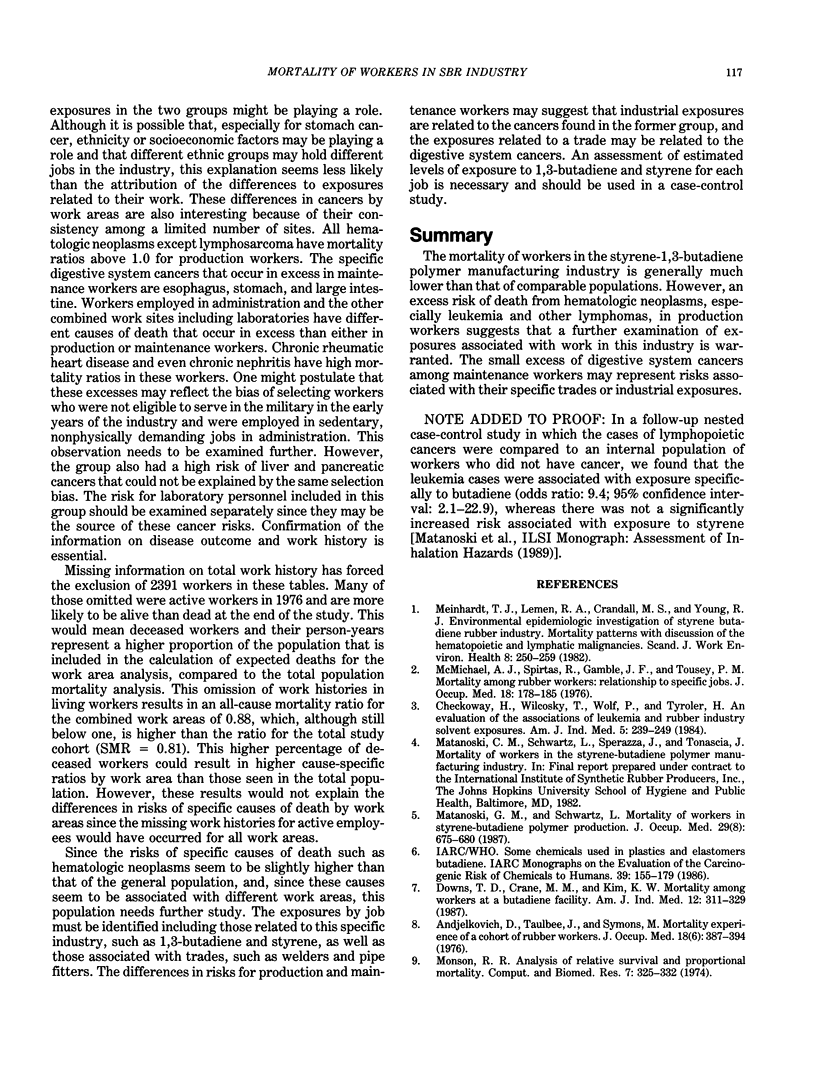Abstract
A cohort of 12,110 male workers employed 1 or more years in eight styrene-butadiene polymer (SBR) manufacturing plants in the United States and Canada has been followed for mortality over a 40-year period, 1943 to 1982. The all-cause mortality of these workers was low [standardized mortality ratio (SMR) = 0.81] compared to that of the general population. However, some specific sites of cancers had SMRs that exceeded 1.00. These sites were then examined by major work divisions. The sites of interest included leukemia and non-Hodgkin's lymphoma in whites. The SMRs for cancers of the digestive tract were higher than expected, especially esophageal cancer in whites and stomach cancer in blacks. The SMR for arteriosclerotic heart disease in black workers was significantly higher than would be expected based on general population rates. Employees were assigned to a work area based on job longest held. The SMRs for specific diseases differed by work area. Production workers showed increased SMRs for hematologic neoplasms and maintenance workers, for digestive cancers. A significant excess SMR for arteriosclerotic heart disease occurred only in black maintenance workers, although excess mortality from this disease occurred in blacks regardless of where they worked the longest. A significant excess SMR for rheumatic heart disease was associated with work in the combined, all-other work areas. For many causes of death, there were significant deficits in the SMRs.
Full text
PDF










Selected References
These references are in PubMed. This may not be the complete list of references from this article.
- Checkoway H., Wilcosky T., Wolf P., Tyroler H. An evaluation of the associations of leukemia and rubber industry solvent exposures. Am J Ind Med. 1984;5(3):239–249. doi: 10.1002/ajim.4700050307. [DOI] [PubMed] [Google Scholar]
- Downs T. D., Crane M. M., Kim K. W. Mortality among workers at a butadiene facility. Am J Ind Med. 1987;12(3):311–329. doi: 10.1002/ajim.4700120307. [DOI] [PubMed] [Google Scholar]
- Matanoski G. M., Schwartz L. Mortality of workers in styrene-butadiene polymer production. J Occup Med. 1987 Aug;29(8):675–680. [PubMed] [Google Scholar]
- McMichael A. J., Spirtas R., Gamble J. F., Tousey P. M. Mortality among rubber workers: Relationship to specific jobs. J Occup Med. 1976 Mar;18(3):178–185. doi: 10.1097/00043764-197603000-00012. [DOI] [PubMed] [Google Scholar]
- Meinhardt T. J., Lemen R. A., Crandall M. S., Young R. J. Environmental epidemiologic investigation of the styrene-butadiene rubber industry. Mortality patterns with discussion of the hematopoietic and lymphatic malignancies. Scand J Work Environ Health. 1982 Dec;8(4):250–259. doi: 10.5271/sjweh.2469. [DOI] [PubMed] [Google Scholar]
- Monson R. R. Analysis of relative survival and proportional mortality. Comput Biomed Res. 1974 Aug;7(4):325–332. doi: 10.1016/0010-4809(74)90010-x. [DOI] [PubMed] [Google Scholar]


